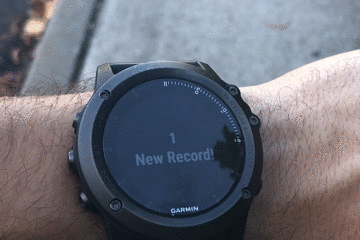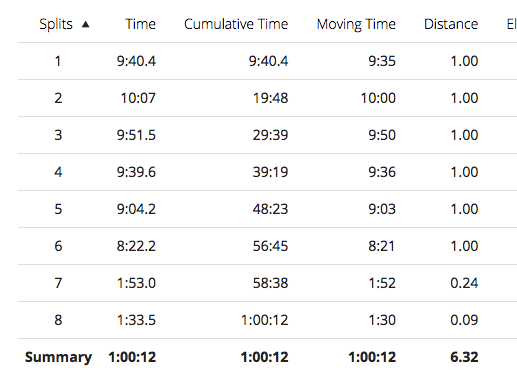You get good at what you train for.
Yesterday I ran a 10K. It was my third attempt at running a 10K for time(I’ve run 10 kilometers before but never trying to do it as fast as possible).
The first time I ran a 10K was about a month ago when it got programed at the gym. In CrossFit world, a 5K is considered endurance. 10Ks are almost unimaginable (though look no farther than Greg Glassman’s 2003 journal article Theoretical Template for CrossFit Programming for a 10K front and center).
There’s 4 categories of time domains for CrossFit WODs, putting an emphasis on which energy system should be getting used: Under 5 minutes, 5–10 minutes, 11–20 minutes, and greater than 20 minutes.
While you’re technically still using the same aerobic energy system whether you’re moving for 20 minutes or 20 hours, there’s still a lot of training differences in endurance events. A 5K is different than a 10K is different than a marathon etc.
The long, slow workouts aren’t sexy. They’re not gonna rack up YouTube hits. They don’t fit nicely into the 60 minute class format 99% of affiliates follow. But they’re necessary for well rounded fitness.
I’ve done many 5Ks — in races, in workouts, as a go to jog distance. My fastest was somewhere around 22 minutes.
When I first ran the 10K for time, I just extrapolated my 5K time for an estimated finish. I was thinking somewhere around 45 minutes, definitely sub 50.
The first half (aka 5K) felt great. But very shortly after passing that mark I felt like I hit a wall. My legs felt heavier. It was a strugle to get a full breath. Within 10 minutes I had to take a walking break. I got frustrated at myself. I couldn’t remember the last time I had to break during a run.
I was determined to finsih the 10K, no matter how slow, to at least get a time to work with. With some off and on running I finished in 1 hour 20 seconds.
When you train at one distance or event, you get really good at that one event. It doens’t mean it translates well to other events.
Test. Retest.
December 3 I’m running my first half marathon at the Palm Beaches Marathon.
I’ve been following a half marathon training plan provided by Garmin on my Fenix 3 HR (I love this thing, I’ll write about it more).
Normally I have one run speed — go. Like gears on an engine I’ve got to develop different speeds. Go and tired walking aren’t going to cut it.
Sunday is the long run day. A few weeks ago it was a two hour run in a low heart rate zone. This forced me to slow my pace way down to be able to keep moving at a jog for 2 hours.
This past Sunday a 10K for time was on the plan. I was excited for it. I felt like I had done a lot of work on pacing. Plan was to hit the first half very slow then crank it up and hopefully come out sub-60 minutes.
I started off at a slower pace, about 10 – 10:30 min/mi. First half felt good. But it was hot. And humid. None of this is unusual in Miami, but it felt particularly more humid than usual.
I started to feel really dehydrated. I didn’t have any water on me and I was in the middle of a bridge with no water fountains. I could keep pushing and risk blacking out, or crank it down, walk, and figure this out another day. I opted for the latter.
I was dissapointed in this run to say the least. But I knew I’d try it again later in the week.
Negative Splits
Tuesday rolls around. It was a cloudy morning, perfect for hiding the sun’s heat. It was windy. I set up my new Orange Mud Gear Vest with a liter of water — no excuse of not having any this time.
I set out on the run. First two miles I slowed myself down to 10:30 min/mi. This was a challenge because out the gate I felt really good and thought my slow jog was in this range, until I looked down I realized I was going 9:30. Slower. Slower.
Next two miles I cranked it up to about 9:45 – 10:00. Grabbed some sips of water. Legs felt good. Energy felt good. Focused on pulling my calves up. Falling forward.
Mile 5 I sped it up to 9 min/mi. Still feeling good. By this point I knew I’d beat the hour. Question was by how much.
Last mile and a quarter I let lose and gave it everything I had left.
The watch vibrated. 10K hit. 58:20. PR by about 2 minutes.

Here’s the breakdown of my splits. I was able to keep my negative splits strategy — running faster in the last miles than I did in the first miles.

You van view all the details of the run here.
While I’m happy with my time I’m even more happy that I didnt let a bad training day derail me. I got back to it, held to the plan, and everything worked out.
3 weeks to the Half Marathon. 4 weeks to the Alafia Ragnar Trail Race.
???





0 Comments